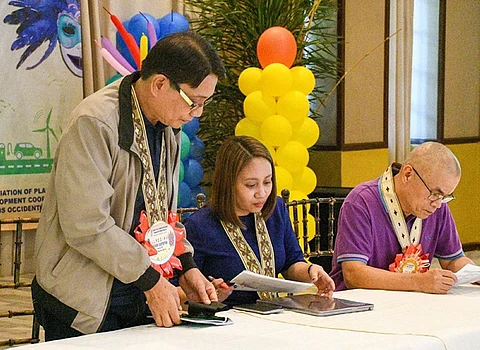

THE National Economic and Development Authority (NEDA) Region VI presented the Western Visayas Regional Development Plan 2023-2028 during the League of Local Planning and Development Coordinators – Western Visayas Regional Convention held last March 28-31, 2023.
The presentation, given by EnP Juvelyn Pamonag of NEDA VI, highlighted the salient features of the 8-point socioeconomic agenda and the region's economy, with a focus on the Regional Spatial Development Strategy (RSDF).
The RSDF, which is based on the Philippine and Regional Development Plan, is guided by the National Spatial Strategy and the Visayas Spatial Development Framework.
The RSDF adopts the core strategies of concentration, connectivity, and vulnerability reduction to provide guidance in the formulation of the land use and physical framework plans of the local government units (LGUs).
The four-day convention with a theme, “Planning for a Risk-Informed Development,” aimed to guide planners in mainstreaming climate change and disaster risk reduction processes into the formulation of Provincial Development and Physical Framework Plans (PDPFPs), Comprehensive Land Use Plans (CLUPs), and other local plans.
Sponsored by the Association of Planning and Development Coordinators (APDEC) Negros Occidental, a chapter of the League of Local Planning and Development Coordinators-Western Visayas Regional Convention, the event provided an opportunity to promote connectivity, enhance resiliency and disaster preparedness, and build sustainable urban development.
In the next six years, Western Visayas will rationalize the development of settlements towards a sustainable economy. The region will foster sustainable urban development, increase productive capacities of agricultural land, and enhance competitiveness of industries to operationalize the concentration strategy.
To promote connectivity, the region will improve linkages to the domestic and global economy through strengthening digital connectivity and enhancing access to domestic and global trade partners. To reduce vulnerability, it will ensure the protection of environmentally critical areas, build disaster and climate resilience, and improve access to social services.
With investments in mind, the region aims to maximize its comparative advantages to strengthen the domestic economy and attain socioeconomic transformation by 2028, recovering from the pandemic's ill effects.
The RDP, having a broader perspective of the sector and spatial directions of the region's development, will guide LGUs in the crafting of their local development strategies, policies, and programs and projects.
The Western Visayas RDP was approved and adopted by the Regional Development Council VI during its CY 2023 1st quarter meeting held last March 24, 2023, in Boracay Island.
EnP Pamonag also presented the Infrastructure Flagship Projects (IFP) in Western Visayas, including the ongoing Bacolod-Negros Occidental Economic Highway, Boracay Circumferential Road, and Jalaur River Multipurpose Project Stage II.
Projects under project preparation phase are also included in the IFP, such as the Antique Airport Development Project, loilo-Capiz-Aklan Expressway (ICAEx), Panay-Guimaras-Negros (PGN) Inter-Island Link Bridge, Panay River Basin Integrated Development Project (PRBIDP), and the upgrading and improvement of the Iloilo International Container Port.
Also in the list are the proposed Iloilo-Santa Barbara Bus Rapid Transit and Panay Railway System, which are on the pre-project preparation phase.
Other priority development projects not identified under the IFP will be included in the Regional Development Investment Program (RDIP), a supplemental document of the RDP 2023-2028.
The RDIP 2023-2028 contains the list of programs and projects to be implemented by the national government, government-owned and controlled corporations, government financial institutions, and other national government offices and instrumentalities within the medium-term that will contribute to the achievement of the societal goal and targets set in the RDP.* (NEDA-PFPD)